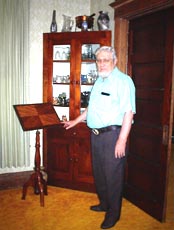"Iíve made
quite a lot of stuff for the kids," he recalls. "I once made a
spinning wheel for a daughter-in-law. If they want something, I make it for
them."
Repair work also
keeps him busy, particularly for the Lincoln school districts. "I keep
their instruments going," he says. "Not long ago I repaired a string
bass for the junior high school. The fingerboard came off. I had to get it in
playing condition the same day."

He accepts money
for repairs only if he has to buy expensive materials. Occasionally he trades a
piece he has made for the work of another artist, perhaps trading a violin for a
painting.
He is especially
proud of one project he did back in the 1960s. "The State Capitol in
Springfield was being restored. The supervisor on the restoration project was
Jim Hickey, then the state librarian. He salvaged some nice pieces of walnut
from the rafters they had to replace and brought them to me.

[Duncan Hannah displays one of two
corner cabinets and a music stand he made in his
basement
woodworking shop.]
"[Then]
Governor Otto Kerner had accumulated a lot of medals and wanted a chest to keep
them in, so I made a chest out of the walnut. I also made desk sets that hold
pens and paper, which went to leading state legislators. As payment I got a
little pile of walnut for my own use. I made a desk set out of it for Robert
Madigan when he first got elected."
Most of the
several dozen musical instruments Duncan has made "from scratch" are
violins, but he has also made violas and dulcimers and is working on a cello.

[Duncan Hannah explains how the top
of a violin is carved little by little from a piece of spruce wood.]
Making a violin is
a long and complicated process, which he doesnít try to hurry. "I could
do the carpenter work in a month or six weeks, if I didnít do anything else,
maybe even eat, but Iíve never done it that way," he says.

The top of the
violin is carved from spruce, a straight-grained wood, and the back and sides
from maple, which is hard and dense. The fingerboards and tail pieces are of
ebony. These woods have been used by violin makers for centuries because they
produce the best tone.

